Place in United Kingdom
| Royal Borough of Kensington and Chelsea | |
|---|---|
| London borough, Royal borough | |
     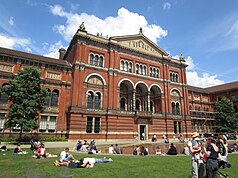
| |
 Coat of arms Coat of arms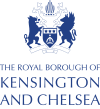 Council logo Council logo | |
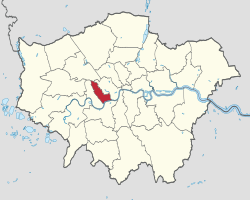 Kensington and Chelsea shown within Greater London Kensington and Chelsea shown within Greater London | |
| Sovereign state | United Kingdom |
| Constituent country | England |
| Region | London |
| Ceremonial county | Greater London |
| Created | 1 April 1965 |
| Admin HQ | Holland Street |
| Government | |
| • Type | London borough council |
| • Body | Kensington and Chelsea London Borough Council |
| • London Assembly | James Small-Edwards (Labour) AM for West Central |
| • MPs |
|
| Area | |
| • Total | 4.68 sq mi (12.13 km) |
| • Rank | 295th (of 296) |
| Population | |
| • Total | 146,154 |
| • Rank | 152nd (of 296) |
| • Density | 31,000/sq mi (12,000/km) |
| Time zone | UTC (GMT) |
| • Summer (DST) | UTC+1 (BST) |
| Postcodes | NW, SW, W |
| Area code | 020 |
| ISO 3166 code | GB-KEC |
| ONS code | 00AW |
| GSS code | E09000020 |
| Police | Metropolitan Police |
| Website | www.rbkc.gov.uk |
The Royal Borough of Kensington and Chelsea (often known by its acronym as RBKC) is an Inner London borough with royal status. It is the smallest borough in London and the second smallest district in England; it is one of the most densely populated administrative regions in the United Kingdom. It includes affluent areas such as Notting Hill, Kensington, South Kensington, Chelsea, and Knightsbridge.
The borough is immediately west of the City of Westminster and east of the London Borough of Hammersmith and Fulham. It contains major museums and universities in Albertopolis, department stores such as Harrods, Peter Jones and Harvey Nichols, and embassies in Belgravia, Knightsbridge and Kensington Gardens. The borough is home to the Notting Hill Carnival, Europe's largest, and contains many of the most expensive residential properties in the world, as well as Kensington Palace, a British royal residence.
The local authority is Kensington and Chelsea London Borough Council. Its motto, adapted from the opening words of Psalm 133, is Quam bonum in unum habitare, which translates roughly as 'How good it is to dwell in unity'.
History
Chelsea and Kensington were both ancient parishes in the historic county of Middlesex. From 1856 the two parishes were in the area governed by the Metropolitan Board of Works, which was established to provide services across the metropolis of London. In 1889 the Metropolitan Board of Works' area was made the County of London. From 1856 until 1900 the lower tier of local government within the metropolis comprised various parish vestries and district boards, with both Chelsea and Kensington being governed by their respective vestries. In 1900 the lower tier was reorganised into metropolitan boroughs, two of which were called Chelsea and Kensington, corresponding to the two parishes. The borough of Kensington was given the honorific title of royal borough in 1901.
The modern borough was created in 1965 under the London Government Act 1963, which reorganised 86 boroughs and urban districts into 32 London boroughs and also created the Greater London Council. It was a merger of the old metropolitan boroughs of Chelsea and Kensington, and it inherited Kensington's royal borough status. The new borough was originally intended to be called only "Kensington", but after protests from thousands of Chelsea residents, the then Minister of Housing and Local Government, Sir Keith Joseph, announced on 2 January 1964 that the name of the new borough would be the Royal Borough of Kensington and Chelsea.
Of its history the council states: "Despite the boroughs being separate originally, Kensington and Chelsea still retain their unique characters. Even the amalgamation of the two boroughs, unpopular as it was at the time, has been accepted. Today conservation combined with the adoption of sympathetic new architecture is seen as a key objective. In every corner of the borough signs of its history can be seen: from Grade 1 listed buildings Kensington Palace and the Royal Hospital, Chelsea to others recalled in street names such as Pottery Lane and Hippodrome Mews."
In 200 years the area has been transformed from a "rural idyll" to a thriving part of the modern metropolis. Chelsea had originally been countryside upon which Thomas More built Beaufort House. He came to Chelsea in 1520 and built the house, which in his day had two courtyards laid out between the house and the river, and in the north of the site acres of gardens and orchards were planted. It was from here in 1535 that More was taken to the Tower and beheaded later that year. This area of Cheyne Walk continued its historic significance; nearby Crosby Hall sits on the river near the Church of Thomas More, and what was once Thomas Carlyle's residence remains on Cheyne Row.
Kensington's royal borough status was granted in 1901 as it included of Kensington Palace, where Queen Victoria was born in 1819 and lived until her accession in 1837. Commissioned by King William III, Christopher Wren enlarged and rebuilt the original house in 1689, turning it into a fitting royal residence. With the King came many court officials, servants and followers. Kensington Square, until then a failing venture, became a popular residential area. The Palace was regularly used by reigning monarchs until 1760 and since then by members of the Royal family. Kensington's royal borough status was inherited by the new borough.
In the 19th century the last emperor of the Sikh Empire, Maharaja Duleep Singh who was brought to England as a child following the Second Anglo-Sikh War, along with the Koh-i-noor diamond, lived in the borough at 53 Holland Park, while his mother Maharani Jind Kaur (wife of Maharaja Ranjit Singh) lived at the nearby Abingdon House till her death in 1846.
During the Second World War civilians suffered great hardship; there were some 800 deaths and 40,000 injuries. A huge army of civilian volunteers was raised, including Auxiliary Fire Service, Red Cross, Air Raid Wardens and Rescue Services. During the Blitz much damage was caused by explosive and incendiary bombs, especially along Chelsea's riverside. But worse was to come in 1944 with the arrival of the V2 rockets, or flying bombs. Among the buildings either destroyed or seriously damaged, usually with terrible loss of life, were Chelsea Old Church, Church of Our Most Holy Redeemer, Our Lady of Victories, St Mary Abbots, St Stephens Hospital, St Mary Abbots Hospital, Sloane Square tube station, World's End, the Royal Hospital and Holland House.
Districts
Areas in the borough include:
- Albertopolis
- Bayswater (also partly in the City of Westminster)
- Belgravia (also partly in the City of Westminster)
- Brompton
- Chelsea
- Chelsea Harbour (also partly in the London Borough of Hammersmith and Fulham)
- Earl's Court
- Holland Park
- Kensal Green (also partly in the London Borough of Brent)
- Kensington
- Knightsbridge (also partly in the City of Westminster)
- Ladbroke Grove
- North Kensington
- Notting Hill
- South Kensington
- West Brompton
- West Kensington (also partly in the London Borough of Hammersmith and Fulham)
- World's End
Parks and open Spaces
Main article: Kensington and Chelsea parks and open spacesMost parks and open spaces in this borough are quite small, the majority being squares built to service houses around them. The area does contain larger parks, containing Kensington Park and parts of Hyde Park, as well as parts of the "Magnificent Seven" cemeteries.
Governance
Main article: Kensington and Chelsea London Borough Council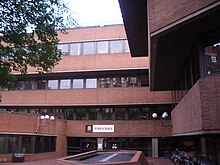
The local authority is Kensington and Chelsea Council, which is based at Kensington Town Hall on Horton Street.
Greater London representation
Since 2000, for elections to the London Assembly, the borough forms part of the West Central constituency.
UK Parliament
The borough is divided between two constituencies represented in the House of Commons of the Parliament of the United Kingdom: Kensington and Bayswater, held by Joe Powell for the Labour Party, and Chelsea and Fulham (partly in Hammersmith & Fulham), held by Ben Coleman for the Labour Party.
At the 2005 General Election, the borough was divided differently:
- Kensington and Chelsea, held by Sir Malcolm Rifkind for the Conservative Party, and
- Regent's Park and Kensington North (partly in City of Westminster), held by Karen Buck for the Labour Party.
Rifkind held the Kensington seat until the 2015 General Election when he stood down after becoming embroiled in a scandal, uncovered by a television investigation, over accepting money in return for access to influential British diplomats and politicians.
| Until 1868 | From 1868 | From 1885 | From Feb 1974 | From 1997 | From 2010 | From 2024 |
|---|---|---|---|---|---|---|
| Middlesex | Chelsea | Kensington North | Kensington | Part of Regent's Park and Kensington North | Kensington | Part of Kensington and Bayswater |
| Kensington South | Kensington and Chelsea | |||||
| Chelsea | Part of Chelsea and Fulham | |||||
Demographics

| Year | Pop. | ±% |
|---|---|---|
| 1801 | 22,088 | — |
| 1811 | 31,085 | +40.7% |
| 1821 | 43,296 | +39.3% |
| 1831 | 55,865 | +29.0% |
| 1841 | 46,807 | −16.2% |
| 1851 | 69,379 | +48.2% |
| 1861 | 128,828 | +85.7% |
| 1871 | 188,277 | +46.1% |
| 1881 | 247,725 | +31.6% |
| 1891 | 258,015 | +4.2% |
| 1901 | 250,267 | −3.0% |
| 1911 | 242,884 | −3.0% |
| 1921 | 243,589 | +0.3% |
| 1931 | 244,297 | +0.3% |
| 1941 | 233,377 | −4.5% |
| 1951 | 223,144 | −4.4% |
| 1961 | 205,598 | −7.9% |
| 1971 | 189,571 | −7.8% |
| 1981 | 125,892 | −33.6% |
| 1991 | 145,171 | +15.3% |
| 2001 | 158,922 | +9.5% |
| 2011 | 158,649 | −0.2% |
| Note: | ||
At the 2011 census, the borough had a population of 158,649 who were 71 percent White, 10 percent Asian, 5 percent of multiple ethnic groups, 4 percent Black African and 3 percent Black Caribbean. It is the least populated of the 32 London boroughs. Due to its high French population it has long held the unofficial title of the 21st arrondissement of Paris.

In 2005, the borough had more of its land covered by domestic buildings than anywhere else in England at 19%, over half the national average. It also had the fifth highest proportion of land covered by non-domestic buildings at 12 percent.
As of 2010 statistics released by the Office for National Statistics showed that life expectancy at birth for females was 89.8 years in 2008–2010, the highest in the United Kingdom. Male life expectancy at birth for the same period was 85.1 years. The figures in 1991–1993 were significantly lower: 73.0 years for males (ranking 301st in the nation) and 80.0 for females (ranking 129th). Further investigation indicates a 12-year gap in life expectancy between the affluent wards of Chelsea (Royal Hospital, Hans Town) and the most northerly wards of North Kensington (Golborne, Dalgarno), which have high levels of social housing and poverty.
The borough has a higher proportion (16.6 percent) of high earners (over £60,000 per year) than any other local government district in the country. It has the highest proportion of workers in the financial sector and the lowest proportion working in the retail sector.
In December 2006 Sport England published a survey which showed that the borough's residents were the fourth most active in England in sports and other fitness activities. 27.9 percent of the population participate at least three times a week for 30 minutes.
A 2017 study by Trust for London and the New Policy Institute found that Kensington & Chelsea has the greatest income inequality of any London Borough. Private rent for low earners was also found to be the least affordable in London. However, the borough's poverty rate of 28% is roughly in line with the London-wide average.
Ethnicity
| Ethnic Group | Year | |||||||||||
|---|---|---|---|---|---|---|---|---|---|---|---|---|
| 1971 estimations | 1981 estimations | 1991 census | 2001 census | 2011 census | 2021 census | |||||||
| Number | % | Number | % | Number | % | Number | % | Number | % | Number | % | |
| White: Total | – | 93.8% | 127,634 | 88.8% | 122,936 | 84.6% | 124,924 | 78.61% | 112,017 | 70.61% | 91,394 | 63.8% |
| White: British | – | – | – | – | – | – | 79,594 | 50.08% | 62,271 | 39.25% | 46,883 | 32.7% |
| White: Irish | – | – | – | – | – | – | 5,183 | 3.26% | 3,715 | 2.34% | 2,825 | 2.0% |
| White: Gypsy or Irish Traveller | – | – | – | – | – | – | – | – | 119 | 0.08% | 84 | 0.1% |
| White: Roma | – | – | – | – | – | – | – | – | – | – | 1,049 | 0.7% |
| White: Other | – | – | – | – | – | – | 40,147 | 25.26% | 45,912 | 28.94% | 40,553 | 28.3% |
| Asian or Asian British: Total | – | – | 5,918 | 4.1% | 8,741 | 6% | 10,329 | 6.50% | 15,861 | 10.00% | 17,025 | 11.8% |
| Asian or Asian British: Indian | – | – | 1274 | 1,711 | 3,226 | 2.03% | 2,577 | 1.62% | 3,209 | 2.2% | ||
| Asian or Asian British: Pakistani | – | – | 634 | 867 | 1,203 | 0.76% | 911 | 0.57% | 1,282 | 0.9% | ||
| Asian or Asian British: Bangladeshi | – | – | 372 | 613 | 1,148 | 0.72% | 836 | 0.53% | 1,488 | 1.0% | ||
| Asian or Asian British: Chinese | – | – | 1,108 | 1,517 | 2,592 | 1.63% | 3,968 | 2.50% | 3,839 | 2.7% | ||
| Asian or Asian British: Other Asian | – | – | 2,530 | 4,033 | 2,160 | 1.36% | 7,569 | 4.77% | 7,207 | 5.0% | ||
| Black or Black British: Total | – | – | 6,581 | 4.6% | 8,259 | 5.7% | 11,081 | 6.97% | 10,333 | 6.51% | 11,279 | 7.9% |
| Black or Black British: African | – | – | 2,176 | 2,891 | 6,013 | 3.78% | 5,536 | 3.49% | 6,944 | 4.8% | ||
| Black or Black British: Caribbean | – | – | 3,148 | 3,701 | 4,101 | 2.58% | 3,257 | 2.05% | 3,237 | 2.3% | ||
| Black or Black British: Other Black | – | – | 1,257 | 1,667 | 967 | 0.61% | 1,540 | 0.97% | 1,098 | 0.8% | ||
| Mixed or British Mixed: Total | – | – | – | – | – | – | 6,505 | 4.09% | 8,986 | 5.66% | 9,525 | 6.6% |
| Mixed: White and Black Caribbean | – | – | – | – | – | – | 1,290 | 0.81% | 1,695 | 1.07% | 1,725 | 1.2% |
| Mixed: White and Black African | – | – | – | – | – | – | 1,057 | 0.67% | 1,148 | 0.72% | 1,288 | 0.9% |
| Mixed: White and Asian | – | – | – | – | – | – | 1,863 | 1.17% | 3,021 | 1.90% | 3,047 | 2.1% |
| Mixed: Other Mixed | – | – | – | – | – | – | 2,295 | 1.44% | 3,122 | 1.97% | 3,465 | 2.4% |
| Other: Total | – | – | 3,619 | 2.5% | 5,364 | 3.7% | 6,080 | 3.83% | 11,452 | 7.22% | 14,150 | 9.9% |
| Other: Arab | – | – | – | – | – | – | – | – | 6,455 | 4.07% | 6,384 | 4.5% |
| Other: Any other ethnic group | – | – | – | – | – | – | – | – | 4,997 | 3.15% | 7,766 | 5.4% |
| Ethnic minority: Total | – | 6.2% | 16,118 | 11.2% | 22,364 | 15.4% | 33,995 | 21.39% | 46,632 | 29.39% | 51,979 | 36.2% |
| Total | – | 100% | 143,752 | 100% | 145,300 | 100% | 158,919 | 100.00% | 158,649 | 100.00% | 143,373 | 100% |
Transport
Underground

The borough has 12 tube stations, on five of the 11 London Underground lines: the Central line, Circle line, District line, Hammersmith & City line and Piccadilly line. The borough contains the stations of South Kensington, Gloucester Road, High Street Kensington, Earl's Court, Sloane Square, West Brompton, Notting Hill Gate, Holland Park, Latimer Road, Knightsbridge, Westbourne Park and Ladbroke Grove.
Crossrail
Chelsea (SW3, SW10 and partly SW1) has significantly less Underground access than Kensington, the only station within Chelsea being Sloane Square. There have for some time been long-term plans for a Chelsea-Hackney line, with a station in the King's Road near Chelsea Town Hall, and possibly another at Sloane Square. As of June 2019, the plans for Crossrail 2 materialising show the proposed route tunnelling through Chelsea and featuring the planned King's Road Chelsea station on the site of Dovehouse Green. The future of this station, being the only fully new station on the proposed line, remains ambiguous; initial reports of the station idea having been scrapped seem to be contradicted by the station's placement on an official Transport for London map for the route.
A Crossrail station on the original Crossrail route, from Paddington to Reading, has been proposed and endorsed by the council. This station would be located near the northern end of Ladbroke Grove, and would serve the areas of North Kensington and Kensal. The council supports this station concept as it would renew infrastructure and build regeneration benefits in the area.
National Rail and Overground
Paddington and Victoria are the nearest major railway termini; National Rail stations in the borough are Kensington (Olympia) and West Brompton (and partly Kensal Green), both served by London Overground and Southern.
Buses
Many London bus routes pass through the borough, most of them along King's Road, Fulham Road, Kensington High Street and Ladbroke Grove.
Cycling
Kensington and Chelsea council has been criticised for its lack of support for cycle lanes and active travel in general. In 2019 the council vetoed a flagship programme by Transport for London for safer walking and cycling in the borough. In 2020 it scrapped a cycle lane along Kensington High Street just seven weeks after it was installed.
Travel to work
In March 2011 the main forms of transport that residents used to travel to work were: underground, metro, light rail, tram, 23.6 percent of all residents aged 16–74; driving a car or van, 8.2 percent; on foot, 8.2 percent; bus, minibus or coach, 8.0 percent; work mainly at or from home, 7.0 percent; bicycle, 3.1 percent; train, 2.1 percent.
Social housing and Grenfell tower fire
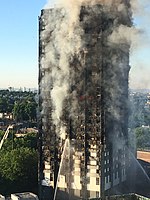
The RBKC is a major provider of social housing in the borough owning 9,459 properties. Of these over 73 percent are tenanted, with the remainder being leasehold. The management of this housing was devolved to the Kensington and Chelsea TMO (KCTMO), a tenant management organisation. Properties included Trellick Tower.
The 2017 Grenfell Tower fire, in which one public-housing tower of the estate Grenfell Tower was completely destroyed and 72 lives were lost, drew international attention to the borough. After widespread criticism of the borough council's response to the fire, responsibility for providing services to those affected by the fire was taken away from RBKC. Prime Minister Theresa May previously branded the response to the tragedy "not good enough", with Whitehall civil servants drafted in as part of a beefed-up operation in the local area. Anna Stec who gave evidence as an expert witness to the Grenfell Tower Inquiry has urged the authorities to test rescue workers, nearby residents and survivors for carcinogenic chemicals following the fire.
Religion
Religion in Royal Borough of Kensington and Chelsea (2018)
Christianity (48.9%) Islam (10.3%) Judaism (4.7%) Hinduism (1.7%) Buddhism (1.7%) Any other religion (6.0%) Non-religious (26.8%)The following shows the religious identity of residents residing in Kensington and Chelsea according to the 2001, 2011 and the 2021 censuses.
| Religion | 2001 | 2011 | 2021 | |||
|---|---|---|---|---|---|---|
| Number | % | Number | % | Number | % | |
| Holds religious beliefs | 120,052 | 75.5 | 110,011 | 69.3 | 93,452 | 65.2 |
| Christian | 98,466 | 62.0 | 86,005 | 54.2 | 69,335 | 48.4 |
| Muslim | 13,364 | 8.4 | 15,812 | 10.0 | 16,865 | 11.8 |
| Jewish | 3,550 | 2.2 | 3,320 | 2.1 | 2,681 | 1.9 |
| Hindu | 1,594 | 1.0 | 1,386 | 0.9 | 1,584 | 1.1 |
| Sikh | 325 | 0.2 | 263 | 0.2 | 319 | 0.2 |
| Buddhist | 1,849 | 1.2 | 2,447 | 1.5 | 1,606 | 1.1 |
| Other religion | 904 | 0.6 | 778 | 0.5 | 1,064 | 0.7 |
| No religion | 24,240 | 15.3 | 32,669 | 20.6 | 35,610 | 24.8 |
| Religion not stated | 14,627 | 9.2 | 15,969 | 10.1 | 14,311 | 10.0 |
| Total population | 158,919 | 100.0 | 158,649 | 100.0 | 143,373 | 100.0 |
Places of worship
The borough has a number of notable churches, including:
- Brompton Oratory – Roman Catholic
- Chelsea Old Church (All Saints) – Church of England
- Holy Trinity Brompton – Church of England
- St Columba's Church, Pont Street – Church of Scotland
- St Luke's Church, Chelsea, Sydney Street – Church of England
- St Mary Abbots – Church of England
- St Sophia's Cathedral – Greek Orthodox Church
- Kensington Temple – Elim Pentecostal Church
It is home to a small Spanish and Portuguese synagogue, several mosques and the Sikh Central Gurudwara in Holland Park. There are two Armenian churches – Saint Sarkis Armenian Church and Church of Saint Yeghiche. Westminster Synagogue is also partially located in the borough.
Diplomatic missions
The borough's notable districts are home to numerous international diplomatic missions:
 Bangladesh
Bangladesh Cameroon
Cameroon Cyprus (residency)
Cyprus (residency) Dominica
Dominica Fiji
Fiji Gambia
Gambia Mauritius
Mauritius Pakistan
Pakistan Saint Vincent and the Grenadines
Saint Vincent and the Grenadines Zambia
Zambia
Embassies
 Armenia
Armenia Belarus
Belarus Denmark
Denmark Ecuador
Ecuador Estonia
Estonia Gabon
Gabon Greece
Greece Guatemala
Guatemala Iraq
Iraq Israel
Israel Jordan
Jordan Lebanon
Lebanon Mongolia
Mongolia Morocco
Morocco Nepal
Nepal The Netherlands
The Netherlands Paraguay
Paraguay Peru
Peru The Philippines (Trade office)
The Philippines (Trade office) Romania
Romania Russian Federation
Russian Federation Slovakia
Slovakia Thailand
Thailand Ukraine
Ukraine Uzbekistan
Uzbekistan Venezuela
Venezuela Vietnam
Vietnam Yemen
Yemen
Featured places

Within the borough there are several of London's tourist attractions and landmarks:
- Brompton Oratory
- Earl's Court
- Harrods
- Hill House School
- Imperial College
- Jumeirah Carlton Tower
- Kensington Arcade
- Kensington High Street
- Kensington Palace
- King's Road
- Ladbroke Grove
- Leighton House Museum
- Notting Hill Gate
- Olympia (part)
- Portobello Road
- Royal Hospital Chelsea
- Saatchi Gallery
- Sloane Street
- The Science Museum and Natural History Museum
- Victoria & Albert Museum
Education
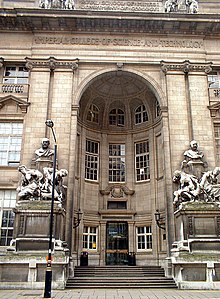
Schools
Main article: List of schools in Kensington and ChelseaThe council's education department finances state schools.
London's Poverty Profile - a 2017 study by Trust for London and the New Policy Institute - found that 75% of 19-year-olds in Kensington and Chelsea have at least a C in their GCSE English and Maths. This is the highest success rate in London.
Independent preparatory schools
- Hill House School, whose notable alumni including King Charles III and actress Anya Taylor-Joy.
- Sussex House School
Further education
Universities
- English National Ballet School
- Royal College of Art
- Royal College of Music
- Imperial College London
- Heythrop College
- Richmond, The American International University in London
- Fordham University
Public libraries

Libraries include the Kensington Central Library, Chelsea Library, Kensal Library, Brompton Library, North Kensington Library and the Notting Hill Gate Library.
International relations
Town twinning
See also: List of twin towns and sister cities in the United KingdomThe Royal Borough of Kensington and Chelsea is formally twinned with:
- Cannes, Alpes-Maritimes, Provence-Alpes-Côte d'Azur, France
Freedom of the Borough
The following people and military units have received the Freedom of Royal Borough of Kensington and Chelsea.
| This list is incomplete; you can help by adding missing items. (July 2020) |
Individuals
- Sir Winston Churchill: 1949. (Borough of Kensington)
Military Units
- The Army Phantom Signal Regiment: 6 October 1959. (Borough of Kensington)
- The Royal Hospital Chelsea: 28 June 2006.
- 31 (City of London) Signal Regiment (V)
- Kensington Regiment (Princess Louise's) Signal Squadron 38 Signal Regiment
- D Company (London Irish Rifles) The London Regiment
- 10 Company 4th Battalion, Parachute Regiment
- 21 Special Air Services Regiment (Artists Rifles) (V)
- 256 (City of London) Field Hospital (V)
- The Royal Yeomanry
- The University of London Air Squadron (V)
- University of London Royal Naval Unit
See also
References
- "How council works: our Mayor: Coat of Arms". Royal Borough of Kensington and Chelsea. Retrieved 16 June 2017.
- Metropolis Management Act 1855 (18 & 19 Vict. c. 120)
- London Government Act 1899 (62 & 63 Vict. c. 14)
- "No. 27378". The London Gazette. 19 November 1901. p. 7472.
- Youngs, Frederic (1979). Guide to the Local Administrative Units of England. Vol. I: Southern England. London: Royal Historical Society. ISBN 0-901050-67-9.
- The Times, 3 January 1964:Chelsea Name Retained: New Decisions on Three Boroughs Linked 14 June 2018
- "The Modern Borough". Rbkc.gov.uk. Retrieved 6 May 2020.
- "Thomas More Comes to Chelsea". Rbkc.gov.uk. Retrieved 18 November 2018.
- "Royalty Comes to Kensington". Rbkc.gov.uk. Retrieved 18 November 2018.
- "The Boroughs at War". Rbkc.gov.uk. Retrieved 18 November 2018.
- "Malcolm Rifkind to stand down as an MP at the election after lobbying controversy". www.newstatesman.com. 24 February 2015. Retrieved 3 June 2015.
- "Kensington: Total Population". A Vision of Britain Through Time Great Britain Historical GIS Project. Retrieved 6 September 2011.
- Emma Rowley (12 May 2012). "High earners say au revoir to France". The Daily Telegraph. Archived from the original on 12 January 2022. Retrieved 14 August 2012.
- ^ "Key Statistics: Dwellings; Quick Statistics: Population Density; Physical Environment: Land Use Survey 2005". Archived from the original on 11 February 2003. Retrieved 25 December 2021.
- Nadine Burham-Marshalleck (31 October 2011). "Kensington & Chelsea has UK's highest life expectancy - South West Londoner". Swlondoner.co.uk. Retrieved 16 June 2017.
- "Top ten fastest growing affluent areas". Business guardian.co.uk. Archived from the original on 25 May 2012. Retrieved 18 November 2018.
- "Active People Survey - headline results". Archived from the original on 20 January 2007. Retrieved 25 February 2010.
- ^ "London Poverty & Inequality - Trust For London". Trust for London.
- ^ "Home". www.npi.org.uk.
- ^ "London's Poverty Profile". Trust for London. Retrieved 19 July 2018.
- "Migration and London's growth" (PDF). LSE.
- Ethnicity in the 1991 census: Vol 3 - Social geography and ethnicity in Britain, geographical spread, spatial concentration and internal migration. Internet Archive. London : HMSO. 1996. ISBN 978-0-11-691655-6.
{{cite book}}: CS1 maint: others (link) - Ethnicity in the 1991 census: Vol 3 - Social geography and ethnicity in Britain, geographical spread, spatial concentration and internal migration. Internet Archive. London : HMSO. 1996. ISBN 978-0-11-691655-6.
{{cite book}}: CS1 maint: others (link) - "KS006 - Ethnic group". NOMIS. Retrieved 30 January 2016.
- "Ethnic Group by measures". NOMIS. Retrieved 8 January 2016.
- "Ethnic group - Office for National Statistics". www.ons.gov.uk. Retrieved 29 November 2022.
- "Crossrail 2 route shake-up: Transport for London's (TfL) business case proposal scraps Kings Road Chelsea station and opts for Tooting over Balham | City A.M". 26 June 2017. Archived from the original on 27 March 2018. Retrieved 6 May 2020.
- "Route Map". CrossRail.
- "Kensal Portobello Crossrail Station | Royal Borough of Kensington and Chelsea". Rbkc.gov.uk. Retrieved 6 May 2020.
- "Kensington and Chelsea vetoes flagship road safety scheme". The Guardian. 14 June 2019. Retrieved 19 August 2022.
- "Kensington and Chelsea council criticised for scrapping cycle lane". The Guardian. 30 November 2020. Retrieved 19 August 2022.
- "2011 Census: QS701EW Method of travel to work, local authorities in England and Wales". Office for National Statistics. Retrieved 23 November 2013.
- ^ "Business Plan 2014-17" (PDF). kctmo.org.uk/ Kensington & Chelsea Tenant Management Organisation. Archived from the original (PDF) on 29 December 2016. Retrieved 18 June 2017.
- Horton, Helena (19 June 2017). "Anger as leader of Kensington Council appears to blame Grenfell residents for sprinklers not being installed". telegraph.co.uk. Daily Telegraph. Archived from the original on 12 January 2022. Retrieved 19 June 2017.
- MacAskill, Ewen (19 June 2017). "Council sidelined in Grenfell Tower response as leader refuses to quit". Guardian.co.uk. The Guardian. Retrieved 19 June 2017.
- Flood, Rebecca (18 June 2017). "Specialist team set up after Grenfell Tower fire after response 'not good enough'". Express.co.uk. Daily Express. Retrieved 18 June 2017.
- "Grenfell soil tests 'reveal huge numbers of cancer forming toxins'". Daily Telegraph. 13 October 2018. Archived from the original on 12 January 2022. Retrieved 7 December 2018.
- "Population by Religion, Borough". Office for National Statistics (ONS). Retrieved 2 June 2020.
- "KS007 - Religion - Nomis - 2001". www.nomisweb.co.uk. Retrieved 18 October 2022.
- "KS209EW (Religion) - Nomis - 2011". www.nomisweb.co.uk. Retrieved 18 October 2022.
- "Religion - 2021 census". Office of National Statistics. 29 November 2022. Archived from the original on 29 November 2022. Retrieved 16 December 2022.
- "Family and Children's Services". Royal Borough of Kensington and Chelsea. 14 June 2016. Retrieved 16 June 2017.
- http://www.rbkc.gov.uk/leisureandlibraries.aspx Royal Borough of Kensington and Chelsea. Retrieved 13 January 2009.
- "British towns twinned with French towns [via WaybackMachine.com]". Archant Community Media Ltd. Archived from the original on 5 July 2013. Retrieved 20 July 2013.
- "Appointment of Honorary Persons". Royal Borough of Kensington and Chelsea. Retrieved 30 November 2016.
- Archived at Ghostarchive and the Wayback Machine: British Pathé (13 April 2014). "Churchill Receives Freedom Of Kensington (1949)". Retrieved 12 March 2017 – via YouTube.
- "Civic Honours granted by the Royal Boroughs". www.steppingforwardlondon.org.
- "Royal Hospital Chelsea gains gift of a lifetime". www.rbkc.gov.uk.
- "Civic Honours – 41 (Princess Louise's Kensington) Squadron 38 Signal Regiment". Royal Borough of Kensington and Chelsea. Retrieved 13 July 2019.
External links
 Media related to Royal Borough of Kensington and Chelsea at Wikimedia Commons
Media related to Royal Borough of Kensington and Chelsea at Wikimedia Commons Royal Borough of Kensington and Chelsea travel guide from Wikivoyage
Royal Borough of Kensington and Chelsea travel guide from Wikivoyage- Kensington & Chelsea Council
- Kensington & Chelsea Local Involvement Network (K&C LINk)
| Governance of Greater London | |
|---|---|
| Regional | |
| Ceremonial |
|
| London Councils | |
| Historical |
|
51°30′N 0°11′W / 51.50°N 0.19°W / 51.50; -0.19
Categories: